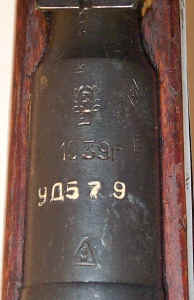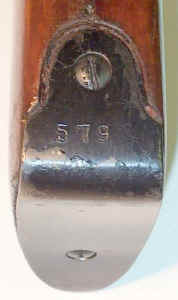Return to Mosin Nagant Virtual
Museum |
All content copyright © 7.62x54r.net |

Although the M38 carbine was adopted in 1938, production did not begin
until 1939 at Izhevsk (1940 at Tula) and examples from this year are relatively
uncommon. The primary difference between the M38 and the M91/30 infantry rifle is
the shorter barrel and shorter rear sight base and leaf which is only graduated to
1,000 meters, rather than 2,000 meters. The earliest production M38 stocks had
the rear barrel band shoulder approximately the same distance forward of the rear sight
base as the M91/30. However, the stocks themselves were not only different in
overall length, but different in length from the buttplate to the rear barrel band
shoulder. Before long the stock was redesigned so that the two models shared common
dimensions from the buttplate to the rear barrel band shoulder. The only differences
then were in the length of the fore end and the handguard. This would certainly have
simplified production allowing both stocks to be made with the same pattern and simply
adjusting the length of the forearm and placement of the sling slot and barrel band
spring. These early stocks are seldom encountered because of their relatively short
time of production and loss to damage over time. This particular carbine was
imported from the Ukraine after being refurbished in the 1970s. In light of this the
fact that it still retains the first pattern stock and handguard is very unusual.
The buttplate is stamped to match with the three digit serial number but lacks the two
Cyrillic letter prefix.

|

|
The bolt and magazine floorplate are also stamped matching with the 3
digit number and no prefix. The receiver is the earlier low wall round pattern that
was replaced by the high wall in 1941.
The stock is fitted to the steps in the receiver tang which are also a
feature of the earlier receivers. The rear sight buttons each have the Tula star
parts mark and may be replacements or furnished by Tula to Izhevsk in 1939. The rear
raised area of the handguard is very short, even compared to an M91/30 handguard.
The stock has the early screwed sling slot escutcheons and no repairs
which is surprising considering it's long service through WWII. The short distance
between the stock shoulder and the carbine rear sight seems unusual when compared to other
carbines. Note the lack of a bayonet groove as found on M44 stocks and the early
pattern rear sight base with the straight ramp.and point above the leaf pin. This
stock also does not have the rear barrel band finger grooves which didn't become standard
until late in WWII.
The distance between the barrel bands is noticeably longer although the
front band and nosecap are in the same position as on later stocks in relationship to the
muzzle. The original cartouches are illegible but there is a clear "circle
2" stamped near the trigger. This was probably done during the last
refurbishment but it's meaning is unknown.
|